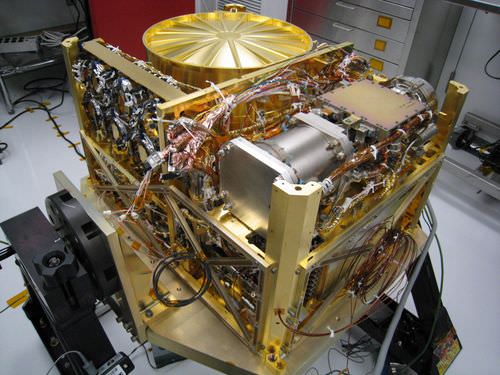What has Curiosity been up to lately? The rover’s Sample Analysis at Mars (SAM) instruments makes up more than half the science payload on board MSL, and it is now searching for compounds of the element carbon — including the enticing methane that has been observed in Mars’ atmosphere from telescopes and instruments on Earth. These are the elements that are associated with life, and SAM is trying to determine if methane can be detected from the surface, as well. So far, the rover has not found “definitive evidence” beyond data uncertainty of methane in Mars’ thin atmosphere. But that doesn’t close the door on the subject. It is still early in the mission, and the methane on Mars has been cyclical in nature.
“A search for methane was made on multiple nighttime runs, but so far we have no definitive detection of methane,” said Chris Webster, the team lead for MSL’s Tunable Laser Spectrometer. The instrument has detected values of no methane at all up to 5 parts per billion, but the “data uncertainty is larger than this,” Webster said. “We do plan on additional runs, of course, to look for variability.”
But, of course, methane has been detected in certain areas, not necessarily planet-wide.
The Sample Analysis at Mars (SAM) instrument, at NASA’s Goddard Space Flight Center, Greenbelt, Md., will analyze samples of material collected by the rover’s arm. Credit: NASA/JPL
“In the Gale Crater, at the moment, we don’t have a definite detection of methane,” said Sushil Atreya, a co-investigator with the SAM instruments. “On the other hand, the source doesn’t have to be at Gale Crater. If there is a source of methane elsewhere, it does not take very long for it to get distributed all over the planet. It takes on the order of about three months. That is all we can say at this point.”
Methane is enticing because it could indicate life of some sort, perhaps microbial life. But methane can also be produced by certain geologic processes, and recently, a team of researchers suggested that methane could even be produced by Martian dust devils.
But as Pan Conrad, deputy principal investigator for SAM says in the video above, the team will continue to explore ways in which methane could be generated and then destroyed in the Martian ecosphere, and make the most of these extremely sensitive instruments that are now on Mars.
“SAM will continue to sniff the Martian atmosphere and look for changes over time,” Conrad said. “That will tell us something about the dynamics between the exchange between the surface and the atmosphere.”


Don’t give up yet Curiosity! When the Mars Express mission sees methane again.. no doubt you will too!
Just re-read ‘Man plus’ by Frederik Pohl. This is the story of creating a cyborg, half man/half machine, designed to live on Mars. Back in 1976, when this novel was written, we’d only just begun to explore Mars with the Viking lander(s) and computers were very primitive compared to today… still, a very prescient and interesting read! (They find life!)
(They find life!)..as did the Vikings at both landing sites which is a valid working theory until those mysterious super-oxidants have been unambiguously proven to exist all over Mars. MSL did not detect any unusual soil chemistry so far…
Regarding the failure to detect methane yet: wrong season and maybe wrong landing site too – if they were out to sniff Martian methane or generally better focusing the life on Mars question they should have chosen Mawrth Vallis.
Indeed, the ambiguous results from both Viking Landers is still hotly debated today in some circles.. as is the origin of the Methane detected by the Mars Express orbiter. Only time will tell! I for one certainly hope that the methane can be pinned to organics.. THAT would change everything!
After reading ‘Man Plus’, I found the follow up novel also by Frederik Pohl, ‘Mars Plus’. In the second read.. cyborgs and computer enhanced Martians link up with a hidden cyber intelligence created by all the linked computer nodes. An interesting concept – that unbeknownst to us, our cyber systems have become sentient. Not an entirely ‘new’ concept.. but interesting anyway!